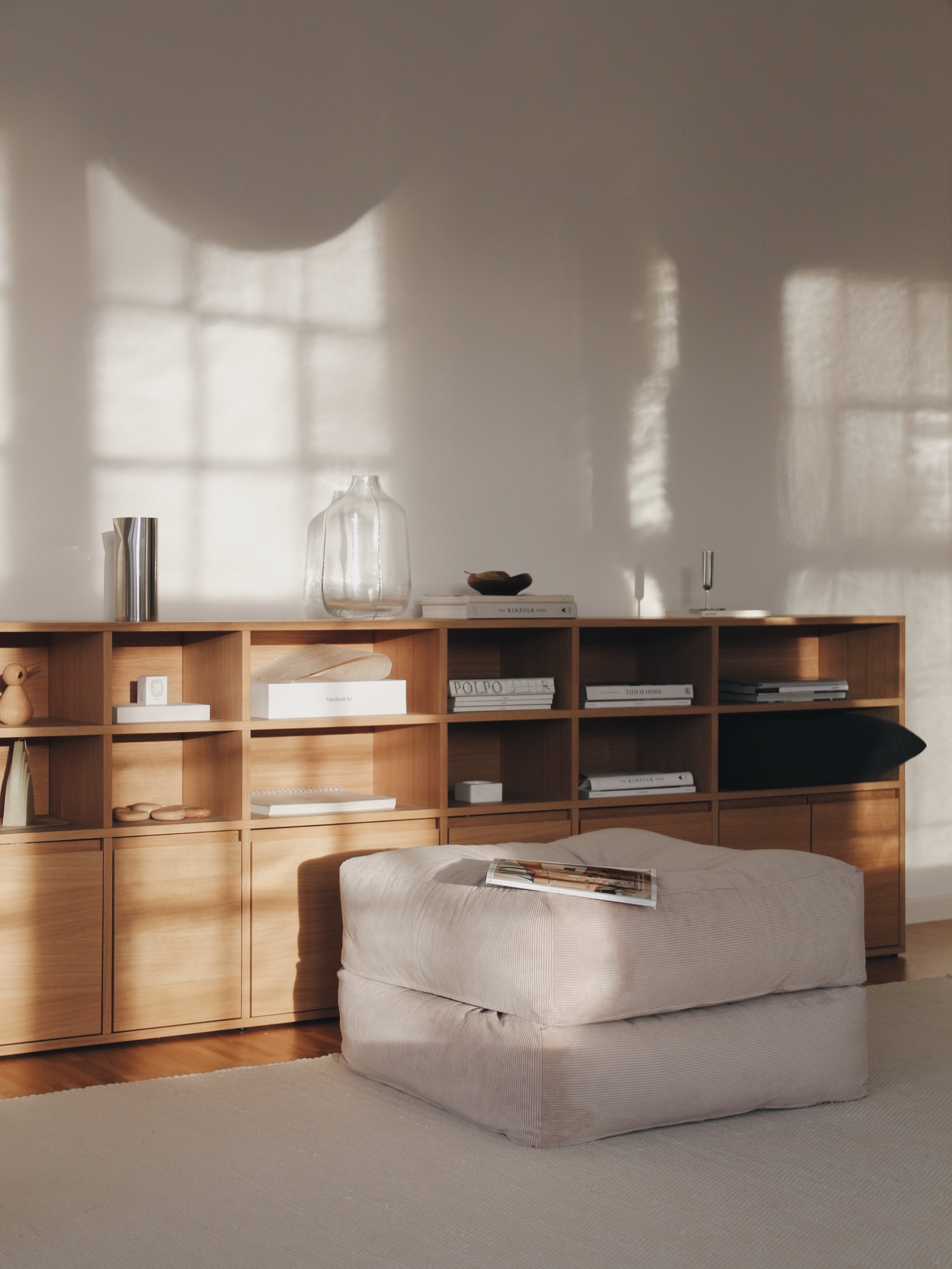14 rules of my mix of Nordic & Japanese warm minimalism = “Japandi” interior style.
Actually, I always prefer to describe my home as an “asymmetrically balanced, somewhat imperfect, somewhat rough, simple, yet warm and elegant mix of Nordic and Japanese layered and warm minimalism.”, but yes - #japandi is shorter, simpler, and it’s a trendy word :)
My mix of Nordic & Japanese warm minimalism in our living room. Vintage teak table, dining Cross Chairs in smoked oak by TAKT. You can find links to almost all products in my photos here: Shop My Home.
So here is the list of the rules I always keep in mind when it’s time to add or change something at my place:
Simplicity and functionality - I prefer to use functional/multipurpose pieces as decor: think of trays, bowls, cushions, throws, beautiful kitchenware, books, candles… Also, I love to use paper rolls and linen canvas as decor - from time to time I create wall art (it’s my hobby), so these paper rolls are also multifunctional for me.
Neutral Color Palette: I use a calming and harmonious color scheme with neutral tones such as white (walls, off-white cotton rug, storage system in the hallway, sometimes bedding, lamps, and tableware), beige, gray, and earthy hues, BUT ->
…I’m not afraid of dark colors - a Japandi home doesn’t have to be all beige. I love to create contrast by adding dark brown (cushions, smoked oak chairs, teak table, teak bowl), dark grey (futon chair), or black elements (vases and some decorative objects). Those objects always become eye-catchers in my space. And yes, I have a black kitchen, almost forgot to mention!
Low-profile wooden or soft furniture with a simple design. Modern modular storage/shelving systems and futon furniture (or poufs) do the trick perfectly. Poufs are also so versatile, they are my all-rounders and “life-savers”.
Low sideboard from Tylko and 2 “More” Poufs by Karup Design. You can find links to almost all products in my photos here: Shop My Home.
5. Mix different wood species and colors to create depth: my favorites are oak, teak, and smoked oak. Look how effortlessly Oezlem Oezsoy did it in her home.
6. Mix vintage and new pieces. Old patinated wood and metals look great in Japandi homes and create visual interest. Vintage pieces add “warmth“ to “minimalism“ and you finally get the sought-after “warm minimalism“.
7. Natural Materials: Incorporate materials like wood, linen, wool, stone to bring warmth and organic textures to the space. Also, they help to ->
8. …embrace imperfection: include imperfect pieces with rough textures, uneven colors, and asymmetrical shapes: handmade ceramics, washed linen, hand-woven baskets, jute rugs… I love a lot of linen and wool items at home, a jute rug (“Lohals” by Ikea), but still looking for a couple of nice baskets and handmade ceramics brands...
9. Bring your own story into your space, make it “lived in”, and don’t try to get rid of your favorite objects if they are not perfectly aligned with the “style”. If you look at real Japanese and Nordic rooms (and not their “styled“ for magazine versions), you’ll always notice tiny things (ok, sometimes not so tiny) that tell you the story of the homeowner.
10. I love rice-paper lampshades, they complement warm minimalist/japandi interiors perfectly - I have big 60-80cm paper “spheres” from Hay almost in every room - they are very lightweight, look good, and are not expensive. My dream is to have a huge 120cm Akari by Isamu Noguchi paper lampshade in our living room and another huge Akari on the floor!
11. Light and Air: maximize natural light by using sheer curtains or no curtains at all. Lightweight Roman or roll curtains also complement this style perfectly. We have no curtains at the moment (wooden blinders outside of the windows only), but I’m looking for appropriate options, because in summer the sun drives me crazy sometimes, especially in a semi-circle living room, where windows are…almost everywhere :))
12. Sometimes I like to add drops of color - but only with the things that can be easily removed from sight any moment when I feel that I’m tired of them (and therefore my colorful items are rarely expensive).
13. Patterns: I prefer no patterns at all or thin, hardly visible stripes or checks patterns.
14. The most important: Arrange storage solutions in your space wisely - one good spacious storage system with lots of shelves and drawers behind its doors helps to keep the rest of your space minimalist, airy, and uncluttered. We have a huge Ikea Platsa system in the hallway. Also, I have some much smaller storage furniture with doors in every room.
Enjoy styling! :)
What else:
My Current Home Edit: “Lost somewhere between Nordic and Japanese layered minimalism. [ 2023 ]

